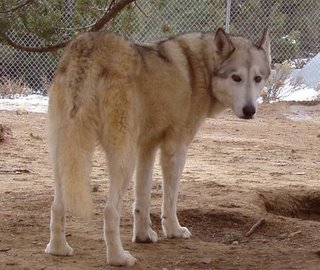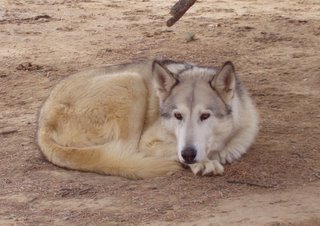
One of the most difficult things to deal with as an animal caretaker at the Sanctuary is watching a sick or injured animal deal with pain. While with our older residents, we expect some deterioration of health and are always cautiously observing, sometimes younger, healthier animals shock us with health problems. Sasquatch for example, appeared in all aspects to be as young and healthy as ever until he began to limp. When we received the doctor's diagnosis and learned Sasquatch had developed bone cancer, we were shocked to say the least. Perhaps one of the most important things to remember working with these animals, is that in the wild, showing weakness can be a death sentence. If a member of the pack begins to show signs of injury or sickness, they are then seen as a weakness and sometimes detrimental to the pack.
Recently, our young, frisky Sequoia shocked us as well. A few weeks ago, we noticed Sequoia had begun limping. For the following week or so, she was observed carefully as well as thoroughly examined by Leyton, our Director, and Gary, our Animal Care Specialist. While they palpated the leg, cautiously observed, and thoroughly examined Sequoia daily, it seemed as though nothing was wrong. It was believed that it may simply be a pad bruise, and that it would go away on it's own. However, Sequoia's limping did not relent and concerned, we made an appointment and took Sequoia for a vet visit.
After being examined, we were told that Sequoia had an ACL injury and was going to need an operation. Sequoia's surgery went smoothly, and it is expected that she will be fine. However, in order for her to heal properly, she must be kept mostly immobile for six to eight weeks. Telling a wolf-dog that she can't move for a long period of time, is not an easy task. Especially with Sequoia, who is normally very young and energetic, as time goes on this is going to prove even more difficult.
Currently Sequoia is in a small isolation enclosure we set up directly outside the office. A low-content animal, Sequoia is extremely social, and each time someone so much as looks in her direction, her tail begins wagging and she begins whimpering softly. While we all know how important it is for her to heal properly, it's constantly heart-breaking to walk past and not be able to return her to the large enclosure she is used to running in freely.
For Sequoia, this must be a very confusing time. How do you explain to a wolf-dog that she has an old football injury which requires so much time to heal? The sad look in her eyes makes me wonder if she thinks she's being punished for something. I often wonder what's going through her head, and if she wonders why we've made her live in such a small space now.

Tonight, after I finished work and everyone had already gone home for the evening, I stepped outside of the office door and sat by her tiny enclosure for a while. I reached my hand in through the opening and scratched her ears, while discouraging her from getting up excitedly. I sat there and talked to her for a long time and tried to explain, and in some ways, I think she understands.
Each member of the two-legged team here has been constantly giving her extra attention to make sure she knows she's not being punished. The first day she was back from the vet, I watched from the picnic tables as Leyton went in to greet her. As he squatted down, she became excited and started to try to jump up to lick his face. I smiled as I watched Leyton telling her "No, don't jump up, you can lick me from where you are, but don't hurt yourself," and Sequoia consistently whimpered, wanting to be her normal energetic self. Even Jim, our assistant to outreach, who normally keeps his animal contact to a minimum has been sitting and talking to Sequoia reguarly. She is definitely well loved here, and everyone is trying to make this as easy for her as possible.
Manu, Sequoia's mate, is also lost right now. With his special, pup-like personality, Sequoia was his constant comfort and stability. Without her, now, he seems to pace around his enclosure as though he is still looking for her and wondering what happened. Both seem so distressed without the other, we're hoping that within a week or so, we'll be able to move Sequoia into the containment area of her old enclosure. At least then she will be near Manu, even if she's still separated by a fence.
I suppose this is always one of the hardest things when working with animals. While we know that we are doing what is best for Sequoia and that this is simply part of the process to help her regain her strength and health, it is still difficult to watch the anxiety that it causes. We hope that she understands when we sit next to her and explain she's not being punished, but it is still a constant wondering that she may be feeling admonished and neglected. With time, as she feels better, but is still healing, it will become more difficult for her to remain confined. But hopefully, with all of the love and concern her care-takers hold for her, she will realize what is happening is for the best.
--Angel
